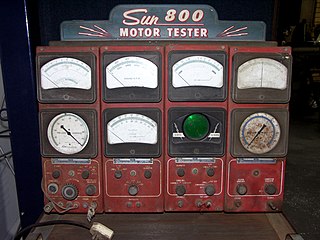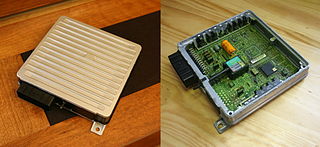Related Research Articles

Electrical engineering is an engineering discipline concerned with the study, design, and application of equipment, devices, and systems which use electricity, electronics, and electromagnetism. It emerged as an identifiable occupation in the latter half of the 19th century after the commercialization of the electric telegraph, the telephone, and electrical power generation, distribution, and use.

Electronics is a scientific and engineering discipline that studies and applies the principles of physics to design, create, and operate devices that manipulate electrons and other electrically charged particles. Electronics is a subfield of electrical engineering, but it differs from it in that it focuses on using active devices such as transistors, diodes, and integrated circuits to control and amplify the flow of electric current and to convert it from one form to another, such as from alternating current (AC) to direct current (DC) or from analog to digital. Electronics also encompasses the fields of microelectronics, nanoelectronics, optoelectronics, and quantum electronics, which deal with the fabrication and application of electronic devices at microscopic, nanoscopic, optical, and quantum scales.

Engine tuning is the adjustment or modification of the internal combustion engine or Engine Control Unit (ECU) to yield optimal performance and increase the engine's power output, economy, or durability. These goals may be mutually exclusive; an engine may be de-tuned with respect to output power in exchange for better economy or longer engine life due to lessened stress on engine components.
Automotive engineering, along with aerospace engineering and naval architecture, is a branch of vehicle engineering, incorporating elements of mechanical, electrical, electronic, software, and safety engineering as applied to the design, manufacture and operation of motorcycles, automobiles, and trucks and their respective engineering subsystems. It also includes modification of vehicles. Manufacturing domain deals with the creation and assembling the whole parts of automobiles is also included in it. The automotive engineering field is research intensive and involves direct application of mathematical models and formulas. The study of automotive engineering is to design, develop, fabricate, and test vehicles or vehicle components from the concept stage to production stage. Production, development, and manufacturing are the three major functions in this field.
A traction control system (TCS), also known as ASR, is typically a secondary function of the electronic stability control (ESC) on production motor vehicles, designed to prevent loss of traction of the driven road wheels. TCS is activated when throttle input and engine power and torque transfer are mismatched to the road surface conditions.

An electronic control unit (ECU), also known as an electronic control module (ECM), is an embedded system in automotive electronics that controls one or more of the electrical systems or subsystems in a car or other motor vehicle.
A vehicle bus is a specialized internal communications network that interconnects components inside a vehicle. In electronics, a bus is simply a device that connects multiple electrical or electronic devices together. Special requirements for vehicle control such as assurance of message delivery, of non-conflicting messages, of minimum time of delivery, of low cost, and of EMF noise resilience, as well as redundant routing and other characteristics mandate the use of less common networking protocols. Protocols include Controller Area Network (CAN), Local Interconnect Network (LIN) and others. Conventional computer networking technologies are rarely used, except in aircraft, where implementations of the ARINC 664 such as the Avionics Full-Duplex Switched Ethernet are used. Aircraft that use AFDX include the B787, the A400M and the A380. Trains commonly use Ethernet Consist Network (ECN). All cars sold in the United States since 1996 are required to have an On-Board Diagnostics connector, for access to the car's electronic controllers.

Electronic throttle control (ETC) is an automobile technology which electronically "connects" the accelerator pedal to the throttle, replacing a mechanical linkage. This concept is often called drive by wire, and sometimes called accelerate-by-wire or throttle-by-wire. A typical ETC system consists of three major components: (i) an accelerator pedal module, (ii) a throttle valve that can be opened and closed by an electric motor, and (iii) a powertrain or engine control module. The ECM is a type of electronic control unit (ECU), which is an embedded system that employs software to determine the required throttle position by calculations from data measured by other sensors, including the accelerator pedal position sensors, engine speed sensor, vehicle speed sensor, and cruise control switches. The electric motor is then used to open the throttle valve to the desired angle via a closed-loop control algorithm within the ECM.

Chip tuning is changing or modifying an erasable programmable read only memory chip in an automobile's or other vehicle's electronic control unit to achieve superior performance, whether it be more power, cleaner emissions, or better fuel efficiency. Engine manufacturers generally use a conservative electronic control unit map to allow for individual engine variations as well as infrequent servicing and poor-quality fuel. Vehicles with a remapped electronic control unit may be more sensitive to fuel quality and service schedules.

An engine control unit (ECU), also called an engine control module (ECM), is a device which controls multiple systems of an internal combustion engine in a single unit. Systems commonly controlled by an ECU include the fuel injection and ignition systems.

This article details the history of electrical engineering. The first substantial practical use of electricity was electromagnetism.
A transmission control unit (TCU), also known as a transmission control module (TCM), or a gearbox control unit (GCU), is a type of automotive ECU that is used to control electronic automatic transmissions. Similar systems are used in conjunction with various semi-automatic transmissions, purely for clutch automation and actuation. A TCU in a modern automatic transmission generally uses sensors from the vehicle, as well as data provided by the engine control unit (ECU), to calculate how and when to change gears in the vehicle for optimum performance, fuel economy and shift quality.
Renix was a joint venture by Renault and Bendix that designed and manufactured automobile electronic ignitions, fuel injection systems, electronic automatic transmission controls, and various engine sensors. Major applications included various Renault and Volvo vehicles. The name became synonymous in the U.S. with the computer and fuel injection system used on the AMC/Jeep 2.5 L I4 and 4.0 L I6 engines.
The following outline is provided as an overview of and topical guide to automobiles:
A transistor is a semiconductor device with at least three terminals for connection to an electric circuit. In the common case, the third terminal controls the flow of current between the other two terminals. This can be used for amplification, as in the case of a radio receiver, or for rapid switching, as in the case of digital circuits. The transistor replaced the vacuum-tube triode, also called a (thermionic) valve, which was much larger in size and used significantly more power to operate.The first transistor was successfully demonstrated on December 23, 1947, at Bell Laboratories in Murray Hill, New Jersey. Bell Labs was the research arm of American Telephone and Telegraph (AT&T). The three individuals credited with the invention of the transistor were William Shockley, John Bardeen and Walter Brattain. The introduction of the transistor is often considered one of the most important inventions in history.
The Ford EEC or Electronic Engine Control is a series of ECU that was designed and built by Ford Motor Company. The first system, EEC I, used processors and components developed by Toshiba in 1973. It began production in 1974, and went into mass production in 1975. It subsequently went through several model iterations.
This article details the history of electronics engineering. Chambers Twentieth Century Dictionary (1972) defines electronics as "The science and technology of the conduction of electricity in a vacuum, a gas, or a semiconductor, and devices based thereon".

The Modular Engine Management System, or MEMS, is an electronic control system used on engines in passenger cars built by Rover Group in the 1990s. As its name implies, it was adaptable for a variety of engine management demands, including electronically controlled carburetion as well as single- and multi-point fuel injection. The abbreviations "SPi" and "MPi" refer to the single-point and multi-point injection configurations, respectively.

Car controls are the components in automobiles and other powered road vehicles, such as trucks and buses, used for driving and parking.

The metal–oxide–semiconductor field-effect transistor, also known as the metal–oxide–silicon transistor, is a type of insulated-gate field-effect transistor (IGFET) that is fabricated by the controlled oxidation of a semiconductor, typically silicon. The voltage of the covered gate determines the electrical conductivity of the device; this ability to change conductivity with the amount of applied voltage can be used for amplifying or switching electronic signals.
References
- ↑ https://www.statista.com/statistics/277931/automotive-electronics-cost-as-a-share-of-total-car-cost-worldwide/ Automotive electronics cost as a share of total car cost, retrieved July 11, 2017
- ↑ VinceC (2019-05-07). "Automotive History: Electronic Ignition – Losing the Points, Part 1". Curbside Classic. Retrieved 2022-10-03.
- 1 2 3 Gosden, D.F. (March 1990). "Modern Electric Vehicle Technology using an AC Motor Drive". Journal of Electrical and Electronics Engineering. Institution of Engineers Australia. 10 (1): 21–7. ISSN 0725-2986.
- ↑ "1960 - Metal Oxide Semiconductor (MOS) Transistor Demonstrated". The Silicon Engine. Computer History Museum.
- ↑ "Who Invented the Transistor?". Computer History Museum . 4 December 2013. Retrieved 20 July 2019.
- ↑ Oxner, E. S. (1988). Fet Technology and Application. CRC Press. p. 18. ISBN 9780824780500.
- ↑ "1971: Microprocessor Integrates CPU Function onto a Single Chip". The Silicon Engine. Computer History Museum . Retrieved 22 July 2019.
- ↑ Benrey, Ronald M. (October 1971). "Microelectronics in the '70s". Popular Science . Bonnier Corporation. 199 (4): 83–5, 150–2. ISSN 0161-7370.
- ↑ "Trends in the Semiconductor Industry: 1970s". Semiconductor History Museum of Japan. Archived from the original on 27 June 2019. Retrieved 27 June 2019.
- ↑ "1973: 12-bit engine-control microprocessor (Toshiba)" (PDF). Semiconductor History Museum of Japan. Archived from the original (PDF) on 27 June 2019. Retrieved 27 June 2019.
- ↑ Belzer, Jack; Holzman, Albert G.; Kent, Allen (1978). Encyclopedia of Computer Science and Technology: Volume 10 - Linear and Matrix Algebra to Microorganisms: Computer-Assisted Identification. CRC Press. p. 402. ISBN 9780824722609.
- ↑ http://www.embedded.com/electronics-blogs/significant-bits/4024611/Motoring-with-microprocessors Motoring with microprocessors, retrieved July 11, 2017
- 1 2 3 Emadi, Ali (2017). Handbook of Automotive Power Electronics and Motor Drives. CRC Press. p. 117. ISBN 9781420028157.
- 1 2 "Design News". Design News . Cahners Publishing Company. 27 (1–8): 275. 1972.
Today, under contracts with some 20 major companies, we're working on nearly 30 product programs—applications of MOS/LSI technology for automobiles, trucks, appliances, business machines, musical instruments, computer peripherals, cash registers, calculators, data transmission and telecommunication equipment.
- ↑ "NIHF Inductee Bantval Jayant Baliga Invented IGBT Technology". National Inventors Hall of Fame . Retrieved 17 August 2019.
- ↑ "MDmesh: 20 Years of Superjunction STPOWER™ MOSFETs, A Story About Innovation". ST Microelectronics . 11 September 2019. Retrieved 2 November 2019.
- ↑ "Automotive Power MOSFETs" (PDF). Fuji Electric . Retrieved 10 August 2019.
- 1 2 Scrosati, Bruno; Garche, Jurgen; Tillmetz, Werner (2015). Advances in Battery Technologies for Electric Vehicles. Woodhead Publishing. ISBN 9781782423980.
- ↑ "IEEE Medal for Environmental and Safety Technologies Recipients". IEEE Medal for Environmental and Safety Technologies . Institute of Electrical and Electronics Engineers . Retrieved 29 July 2019.
- ↑ "Keywords to understanding Sony Energy Devices – keyword 1991". Archived from the original on 4 March 2016.
- ↑ Chris Isidore (22 Mar 2021) Computer chip shortage starting to hit automakers where it hurts
- ↑ https://www.eetimes.com/document.asp?doc_id=1279038 Tech Trends:Security concerns for next-generation automotive electronics, retrieved November 11, 2017
- ↑ Auto, öffne dich! Sicherheitslücken bei BMWs ConnectedDrive Archived 2020-11-23 at the Wayback Machine , c't, 2015-02-05.